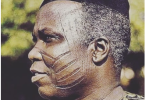Traditional Nigerian music originated out of centuries of functional usage to support trade, social and economic activities. Music was originally used by the various ethnic tribes of Nigeria as morale booster, and for singing praises. It was also used for telling stories of folklore and ancient history. In each case, traditional Nigerian music is sung to match the context and occasion for which it is sung. It is not merely for entertainment, quite unlike modern music.
Thus, there are special traditional Nigerian music types sung for each vocation, daily activity, and occasion. These include funerals, weddings, fishing, farming, and different vocations. The same pattern of functional traditional songs have been used all over Africa for centuries. Furthermore, modern Nigerian music genres have evolved from a fusion of several traditional Nigerian music genres, and Western ones.
Musical Instruments that Comprise Traditional Nigerian Music
To an extent, religion has been a strong influence in the continuity or otherwise of traditional Nigerian music. Christianity and Islam began to spread across Nigeria between the 11th and 15th Centuries. From then till now, there have been deliberate attempts to adapt traditional Nigerian music to these new beliefs (rather than face extinction). This was because traditional music was aforetime seen as praise singing to native gods, which was abhorred by both religions. Such adaptation has helped traditional Nigerian music in their various genres to survive, evolve and be blended to create newer ones.
A key aspect of traditional Nigerian music are the traditional musical instruments. Musical instruments found in each ethnic tribe and region are strongly influenced by indigenous trades/occupations, lifestyle, and environmental factors.
In the savannah regions of northern Nigeria where cattle rearing is prevalent, animal skins are often used to create membranes, bows and string instruments. Good examples include the Goge and Molo. While the forests of southern Nigeria provide abundant supply of materials such as wood, gourds for making musical instruments. You will find sekere (beaded gourds), wooden gongs, xylophones, flutes, and thumb pianos in southern Nigeria. Thus the available local materials are used to create musical instruments indigenous to each environment.
Yet again, an environment in which a particular trade is commonly practiced can have an influence on local musical instruments. In communities where there are many blacksmiths, you will find metallic musical instruments such as metal gongs and bells. The ceremonial long trumpet called Kaakaki (in Northern Nigeria) was imported from the Arab world, and is typically of metallic material.
However, a notable group of traditional musical instruments in Nigeria (and across the whole of Africa) are DRUMS. Virtually every Nigerian tribe has its own native drums; and they come in an amazing variety. Drums supply the background beats and dictate the pace of songs. Furthermore, each type of drum serves its own distinct purpose. Some of the common traditional drums in Nigeria include Bata, Djembe, Gongo, Ekomo, Sakara, and Sato.
As we speak, many of these traditional musical instruments are actively used in modern Nigerian music. Their players offer exciting rhythms and beats that have made modern Nigerian music to become even more thrilling and enjoyable to listen to.
The Various Genres of Traditional Nigerian Music
Let us make mention of some popular music genres that comprise traditional Nigerian music, and their origins, in this article.
Juju
Juju music was made popular in Nigeria sometime between the 1920s and 1930s by Tunde King. It was a blend of Yoruba music, Brazilian instruments, Islamic percussion, and brass instruments. Over time, electric guitars, keyboards, local and foreign drums, and other advanced instruments were added. However, Juju music was said to originate from the Palm Wine music of the Kru people in Liberia, with addition of some European instruments.
Apala
Apala is traditional Yoruba music with a strong dose of percussion instruments. It evolved out of the Islamic wake-up chants during the fasting days of the month of Ramadan. The most popular instruments used in this music genres are the agidigbo (thumb piano), shekere, and agogo (metallic bell). One of the foremost exponents of Apala music in Nigeria was Haruna Ishola.
Fuji
Fuji music is an adaptation of Apala music. However, it became a blend infused with other genres such as Juju, Sakara, Highlife, Aro, and Gudugudu. Popular exponents of Fuji music include Sikiru Ayinde Barrister and Kollington Ayinla.
Waka
Waka is another traditional Yoruba music commonly sung by women. The most popular exponents of that genre in the course of history include Salawa Abeni and Batile Alake.
Highlife
Highlife originated in colonial Ghana, a popular jazz-based music genre enjoyed by the elite who could afford to visit clubs to socialize. In a short while, it spread to other countries of West Africa. It became extremely popular amongst the Igbo and South-South tribes of Nigeria.
It has evolved from being used to recount everyday struggles and yearnings of the typical African, to praise singing and other mundane things. However, the exciting blend of wind instruments, the guitar, and African rhythms that typify highlife are unforgettable.
Afrobeat
Afrobeat is an energetic blend of jazz, funk, highlife and Fuji, infused with Yoruba rhythms (and a good dose of Pidgin English). Furthermore, the music employed a question-and-answer, call-and-response style of singing. The lead singer calls out to backup singers, who respond with rhythmic chants.
It became an extremely popular Nigerian music genre following its propagation by the legendary creator, Fela Kuti. The musician and political activist used his music as a channel to demand for social change back home. Over time, it became not just a pan-African music genre, but a worldwide music revolution that has inspired several other music artists.







